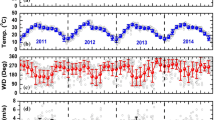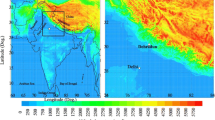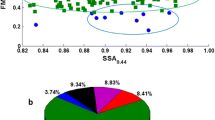Abstract
Collocated measurements of the optical and physical properties of columnar and near-surface aerosols were carried out from Manora Peak, Nainital (a sparsely inhabited, high altitude location, ∼2 km above mean sea level, in the Himalayas), during the Integrated Campaign for Aerosols, gases and Radiation Budget (ICARB) under the Geosphere Biosphere Programme of the Indian Space Research Organization (ISRO-GBP). Under this, observational data of spectral aerosol optical depths (AOD), mass concentration of aerosol black carbon (M B ), mass concentration (M T ) and number concentration (N t ) of composite (total) aerosols near the surface and meteorological parameters were collected during the period February 15 to April 30, 2006. Though very low (<0.1 at 500 nm) AODs were observed during clear days, as much as a four-fold increase was seen on hazy days. The Ångström exponent (α), deduced from the spectral AODs, revealed high values during clear days, while on hazy days α was low; with an overall mean value of 0.69 ± 0.06 for the campaign period. BC mass concentration varied between 0.36 and 2.87 μg m−3 and contributed in the range 0.7 to 1.8% to the total aerosol mass. Total aerosol number concentration and BC mass concentration showed diurnal variation with a midnight and early morning minimum and a late afternoon maximum; a pattern quite opposite to that seen in low altitude stations. These are attributed to the dynamics of the atmospheric boundary layer.
Similar content being viewed by others
References
Ångström A 1961 Techniques of determining the turbidity of the atmosphere; Tellus 13 214–223.
Babu S S and Moorthy K K 2002 Aerosol black carbon over a tropical coastal station in India; Geophys. Res. Lett. 29(23) 2098, doi: 10.1029/2002GL015662.
Babu S S, Satheesh S K and Moorthy K K 2002 Aerosol radiative forcing due to enhanced black carbon at an urban site in India; Geophys. Res. Lett. 29(18): art. No. 1880.
Babu S S, Moorthy K K and Satheesh S K 2004 Aerosol Black Carbon over Arabian Sea during Inter Monsoon and Summer Monsoon Seasons; Geophsys. Res. Lett. 31 L06104, doi: 10.1029/2003GL018716.
Bhugwant C, Bessafi M, Riviere E and Leveau J 2001 Diurnal and seasonal variation of carbonaceous aerosols at a remote MBL site of La Reunion Island; Atmos. Res. 57 105–121.
Haywood J M and Shine K P 1995 The effect of anthropogenic sulfate and soot aerosol on the clear sky planetary radiation budget; J. Geophys. Res. 22(5) doi: 10.1029/95GL00075 603-606.
Haywood J M and Ramaswamy V 1998 Global sensitivity studies of the direct forcing due to anthropogenic sulphate and black carbon aerosols; J. Geophys. Res. 103 6043–6058.
Latha K M and Badarinath K V S 2003 Black carbon aerosols over tropical urban environment-A case study; Atmos. Res. 69 125–133.
McCartney E J 1976 Optics of the Atmosphere (New York: John Wiley & Sons) 135–136.
Moorthy K K, Niranjan K, Narasimhamurthy B, Agashe V V and Murthy B V K 1999 Aerosol Climatology over India, 1. ISRO GBP MWR network and database; Scientific Report ISRO GBP SR 03 99 Indian Space Research Organization, India.
Moorthy K K, Saha A, Prasad B S N, Niranjan K, Jhurry D and Pillai P S 2001 Aerosol optical over peninsular India and adjoining oceans during the INDOEX campaigns: Spatial, temporal and spectral characteristics; J. Geophys. Res. 106 28,539–28,554.
Moorthy K K, Satheesh S K and Babu S S 2006a ICARB-An Integrated Campaign for Aerosols, gases and Radiation Budget over India; Proc. SPIE 6408 64080P-1,7, 0277-786X/06/$15, doi: 10.1117/12.696110.
Moorthy K K and Babu S Suresh 2006b Aerosol black carbon over Bay of Bengal observed from an island location, Port Blair: Temporal features and long-range transport; J. Geophys. Res. 111 D17205 doi: 10.1029/2005JD006855.
Pant P, Hegde P, Dumka U C, Sagar R, Satheesh S K, Moorthy K K, Saha A and Srivastava M K 2006 Aerosol characteristics at a high-altitude location in central Himalayas: Optical properties and radiative forcing; J. Geophys. Res. 111 D17206 doi: 10.1029/2005JD006768.
Ramana M V, Ramanathan V and Podgorny I A 2004 The direct observations of large aerosol radiative forcing in the Himalayan region; J. Geophys. Lett. 31 L05111 doi: 10.1029/2003GL018824.
Reddy M S and Venkataraman C 1999 Direct radiative forcing from anthropogenic carbonaceous aerosols over India; Curr. Sci. 76 1005–1011.
Sagar R, Kumar B, Dumka U C, Moorthy K K and Pant P 2004 Characteristics of aerosol spectral optical depths over Manora Peak: A high altitude station in the central Himalayas; J. Geophys. Res. 109 D06207 doi: 10.1029/2003JD003954.
Satheesh S K and Moorthy K K 1997 Aerosol characteristics over coastal regions of the Arabian Sea; Tellus 49B 417–428.
Shaw G E, Regan J A and Herman B M 1973 Investigations of atmospheric extinctions using direct solar radiation measurements made with a multiple wavelength radiometer; J. Appl. Meteor. 12 374–380.
Singh S and Singh R 2004 High-altitude clear-sky direct solar ultraviolet irradiance at Leh and Henle in the western Himalayas: Observations and model calculations; J. Geophys. Res. 109 D19201 doi: 10.1029/2004JD004854.
Singh S, Nath S, Kohli R and Singh R 2005 Aerosols over Delhi during pre-monsoon months: Characteristics and effects on surface radiation forcing; Geophys. Res. Lett. 32 L13808 doi:10.1029/2005GL023062.
Smirnov A, Holben B N, Dubovik O, O’Neill N T, Eck T F, Westphal D L, Goroch A K, Pietras C and Slutsker I 2002 Atmospheric Aerosol Optical Properties in the Persian Gulf Region; J. Atmos. Sci. 59 620–634.
Sumanth E, Mallikarjuna K, Joshi Stephen, Moole Mahesh, Vinoj V, Satheesh S K and Moorthy K K 2004 Measurements of aerosol optical depths and black carbon over Bay of Bengal during post-monsoon season; Geophys. Res. Lett. 31 L16115, doi: 10.1029/2004GL020681.
Tripathi S N, Dey S, Tare V and Satheesh S K 2005 Aerosol black carbon radiative forcing at an industrial city in northern India; Geophys. Res. Lett. 32 L08802, doi:10.1029/2005GL022515.
Author information
Authors and Affiliations
Corresponding author
Rights and permissions
About this article
Cite this article
Dumka, U.C., Moorthy, K.K., Pant, P. et al. Physical and optical characteristics of atmospheric aerosols during ICARB at Manora Peak, Nainital: A sparsely inhabited, high-altitude location in the Himalayas. J Earth Syst Sci 117 (Suppl 1), 399–405 (2008). https://doi.org/10.1007/s12040-008-0041-y
Received:
Revised:
Accepted:
Published:
Issue Date:
DOI: https://doi.org/10.1007/s12040-008-0041-y




